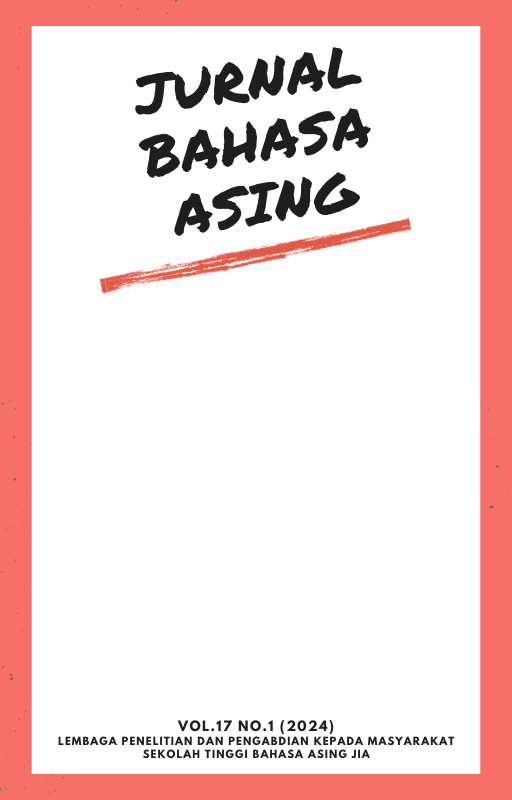Register in Ensemble Stars Music Game
DOI:
https://doi.org/10.58220/jba.v17i1.77Keywords:
Discourse Analysis, Register, Video GameAbstract
This research aims to describe the linguistic form, discover the meaning, and identify the register's function in the Ensemble Stars Music game. The theories applied are Finegan's theory to describe register linguistic forms, Halliday's theory to find register meaning, and identify register functions. This study uses a qualitative methodology by way of discourse analysis. The data taken is in the form of words related to gameplay. From the 25 data found, there are 14 single words, 7 compound words, and 4 shortenings divided into 3 initialisms and 1 acronym. Regarding the meaning discovered, most registers are classified as open variations compared to closed ones. Based on the analysis, the register function that appears the most is personal. In addition, the registers also have imaginative, representational, interactional, and instrumental functions.
Downloads
References
Biber, D., & Conrad, S. (2009). Register, genre, and style. Cambridge University Press.
Bloom, L., & Lahey, M. (1978). Language development and language disorders. Wiley.
Creswell, J. W. (2014). Research design: Qualitative, quantitative, and mixed methods approaches. SAGE Publications.
Fasold, R., & Connor-Linton, J. (2006). An introduction to language and linguistics. Cambridge University Press.
Finch, G. (2000). Linguistic terms and concepts. Springer.
Finegan, E. (2008). Language: Its structure and use (5th ed.). University of Southern.
Gee, J. P. (2005). An introduction to discourse analysis (2nd ed.). Taylor & Francis.
Gee, J. P. (2011). An introduction to discourse analysis (3rd ed.). Taylor & Francis.
Gee, J. P. (2015). Unified discourse analysis: Language, reality, virtual worlds, and video games. Routledge.
Halliday, M. A. K. (1973). Explorations in the functions of language. Edward Arnold Ltd.
Halliday, M. A. K., & Hasan, R. (1976). Cohesion in English. Longman.
Halliday, M. A. K., & Hasan, R. (1989). Language, context, and text: Aspects of language in a social-semiotic perspective. Oxford University Press.
Holmes, J. (2013). An introduction to sociolinguistics (4th ed.). Routledge.
Huberman, A. M., & Miles, M. B. (2013). Innovation up close: How school improvement works. Springer Science & Business Media.
Jones, R. H., Chik, A., & Hafner, C. A. (2015). Discourse and digital practices: Doing discourse analysis in the digital age. Taylor & Francis.
Krippendorff, K. (2004). Content analysis: An introduction to its methodology (2nd ed.). Sage.
McCarthy, M. (1991). Discourse analysis for language teachers. Cambridge University Press.
Merriam-Webster. (n.d.). Merriam-Webster.com dictionary. Retrieved July 8th, 2023, from https://www.merriam-webster.com/
Halimah, N. (2020). Analisis makna ragam bahasa register kalangan remaja dalam media sosial YouTube. [Undergraduate Thesis]. https://digilibadmin.unismuh.ac.id/upload/11415-Full_Text.pdf
Prima, R. B. (2019). Register and power in Indonesian online game (A sociolinguistic study). Center for Humanities Studies, 18(2), 193-207. http://dx.doi.org/10.24036/humanus.v18i2.1-07169
Rahmawati, A. (2014). A sociolinguistics analysis of registers used on soccer pages on social media Facebook. [Publication Article]. https://eprints.ums.ac.id/29797/9/PUBLICATIONS_ARTICLE.pdf
Renkema, J., & Schubert, C. (2018). Introduction to discourse studies: New edition. John Benjamins Publishing Company.
Schiffrin, D. (1987). Discourse markers. Cambridge University Press.
Taylor, S. J., Bogdan, R., & DeVault, M. (2015). Introduction to qualitative research methods: A guidebook and resource (4th ed.). John Wiley & Sons.
Walliman, N. (2011). Research methods: The basics. Routledge.
Wertz, F. J. et al., (2011). Five ways of doing qualitative analysis: phenomenological psychology, grounded theory, discourse analysis, narrative research, and intuitive inquiry. The Guilford Press.
Widdowson, H. G. (1979). Explorations in applied linguistics. Oxford University Press.
Downloads
Published
How to Cite
Issue
Section
License
Copyright (c) 2024 Mifta Ramdani Uflih, Elsan Arvian, Yeni Noryatin

This work is licensed under a Creative Commons Attribution-NonCommercial-ShareAlike 4.0 International License.
The submission has not been previously published, nor is it before another journal for consideration.
Pengajuan belum pernah dipublikasikan sebelumnya, juga tidak sebelum jurnal lain untuk dipertimbangkan.















